The AMD Radeon R9 290 Review
by Ryan Smith on November 5, 2013 12:01 AM EST- Posted in
- GPUs
- AMD
- Radeon
- Hawaii
- Radeon 200
Compute
Jumping into pure compute performance, this is another scenario where the 290X shouldn’t throttle as much, and as such the performance differences between the 290 and 290X should be closer to what they are on paper. With compute workloads the ROPs aren’t being hit hard, so that’s power and thermal savings that lets both cards operate at close to their maximum boost clocks.
As always we'll start with our DirectCompute game example, Civilization V, which uses DirectCompute to decompress textures on the fly. Civ V includes a sub-benchmark that exclusively tests the speed of their texture decompression algorithm by repeatedly decompressing the textures required for one of the game’s leader scenes. While DirectCompute is used in many games, this is one of the only games with a benchmark that can isolate the use of DirectCompute and its resulting performance.
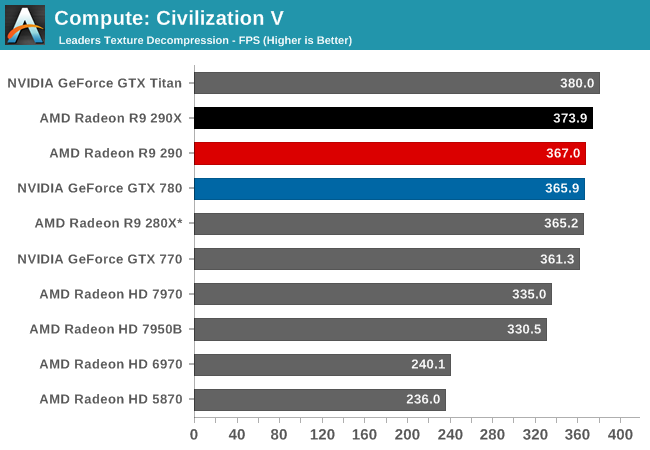
As with the 290X, Civ V can’t tell us much of value due to the fact that we’re running into CPU bottlenecks, not to mention increasingly absurd frame rates. The 290 is marginally slower than the 290X due to the lower clockspeeds and missing CUs, but minimally so.
Our next benchmark is LuxMark2.0, the official benchmark of SmallLuxGPU 2.0. SmallLuxGPU is an OpenCL accelerated ray tracer that is part of the larger LuxRender suite. Ray tracing has become a stronghold for GPUs in recent years as ray tracing maps well to GPU pipelines, allowing artists to render scenes much more quickly than with CPUs alone.
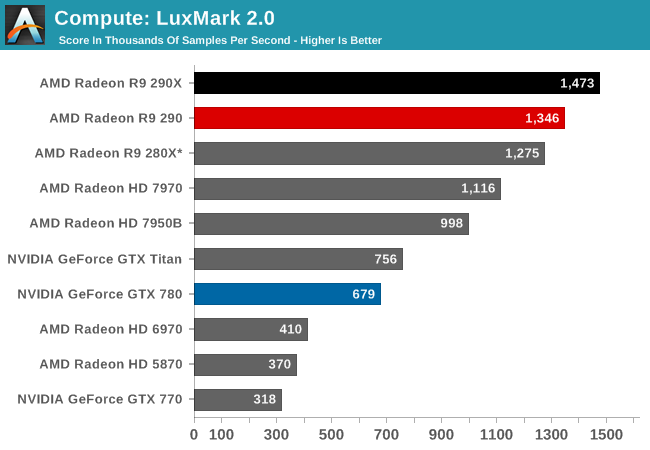
With both cards unthrottled and bound solely by shader performance, it’s an outright foot race for the Radeon cards. 290 trails 290X by around 9%, closely mirroring the difference in the CU count between the two cards. Though 290 is being very closely chased by the 280X, as Hawaii in general seems to have trouble getting the most out of its shader hardware on this benchmark.
Our 3rd compute benchmark is Sony Vegas Pro 12, an OpenGL and OpenCL video editing and authoring package. Vegas can use GPUs in a few different ways, the primary uses being to accelerate the video effects and compositing process itself, and in the video encoding step. With video encoding being increasingly offloaded to dedicated DSPs these days we’re focusing on the editing and compositing process, rendering to a low CPU overhead format (XDCAM EX). This specific test comes from Sony, and measures how long it takes to render a video.
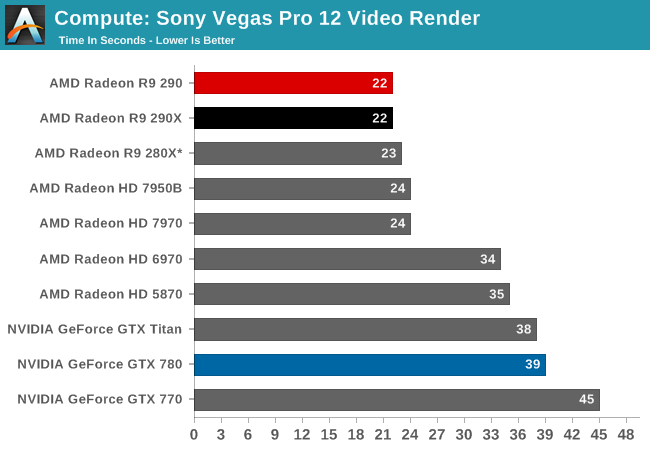
There’s not enough of a GPU performance difference between the two cards to matter with this test. Both tie at 22 seconds.
Our 4th benchmark set comes from CLBenchmark 1.1. CLBenchmark contains a number of subtests; we’re focusing on the most practical of them, the computer vision test and the fluid simulation test. The former being a useful proxy for computer imaging tasks where systems are required to parse images and identify features (e.g. humans), while fluid simulations are common in professional graphics work and games alike.
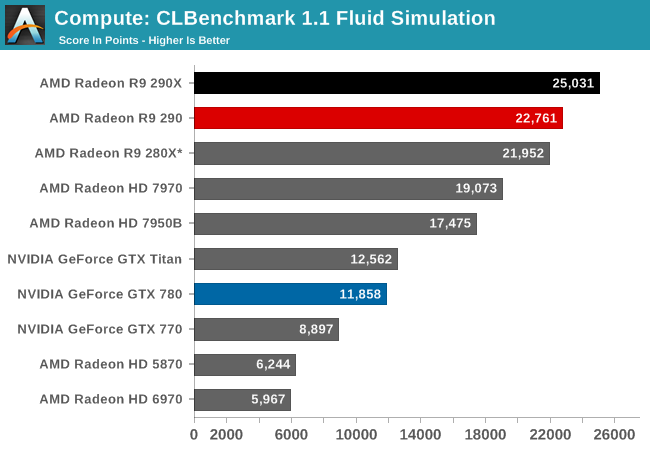

In the CLBenchmark fluid simulation the 290X and 290 take the top spots as expected, with the 290 trailing once more by 9%. However both Hawaii cards are still struggling with the computer vision benchmark, leading to the 290 being edged out by the 7970 of all things.
Moving on, our 5th compute benchmark is FAHBench, the official Folding @ Home benchmark. Folding @ Home is the popular Stanford-backed research and distributed computing initiative that has work distributed to millions of volunteer computers over the internet, each of which is responsible for a tiny slice of a protein folding simulation. FAHBench can test both single precision and double precision floating point performance, with single precision being the most useful metric for most consumer cards due to their low double precision performance. Each precision has two modes, explicit and implicit, the difference being whether water atoms are included in the simulation, which adds quite a bit of work and overhead. This is another OpenCL test, as Folding @ Home has moved exclusively to OpenCL this year with FAHCore 17.
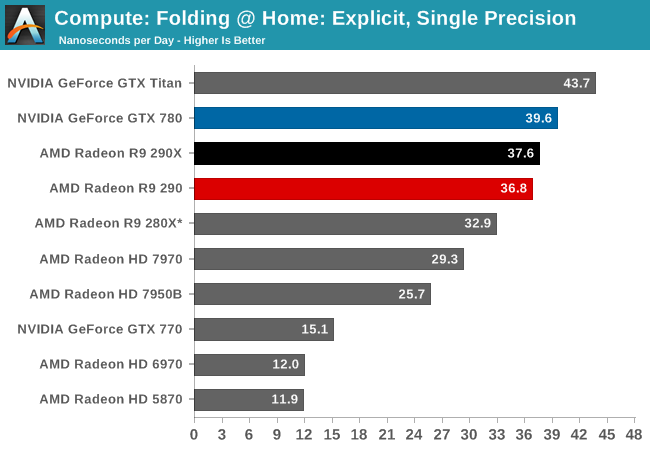
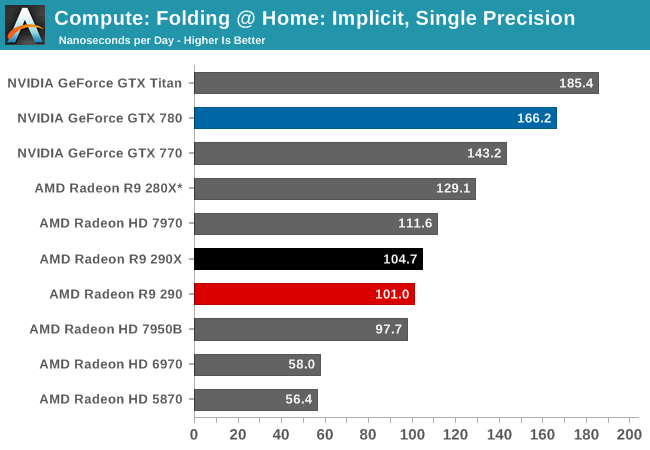
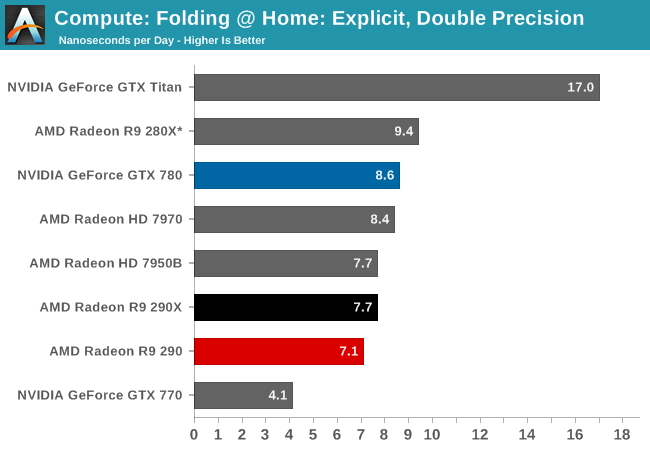
Generally Tahiti and Hawaii are strong performers in the GPU compute arena, but that isn’t of particular help to the 290 here, as it loses out to the GTX 780 in every mode. In single precision FAHBench has trouble putting Hawaii to good use at times, while double precision tests have the 1/8th DP rate 290 and 290X falling behind due to their lower than Tahiti DP throughput.
Wrapping things up, our final compute benchmark is an in-house project developed by our very own Dr. Ian Cutress. SystemCompute is our first C++ AMP benchmark, utilizing Microsoft’s simple C++ extensions to allow the easy use of GPU computing in C++ programs. SystemCompute in turn is a collection of benchmarks for several different fundamental compute algorithms, as described in this previous article, with the final score represented in points. DirectCompute is the compute backend for C++ AMP on Windows, so this forms our other DirectCompute test.
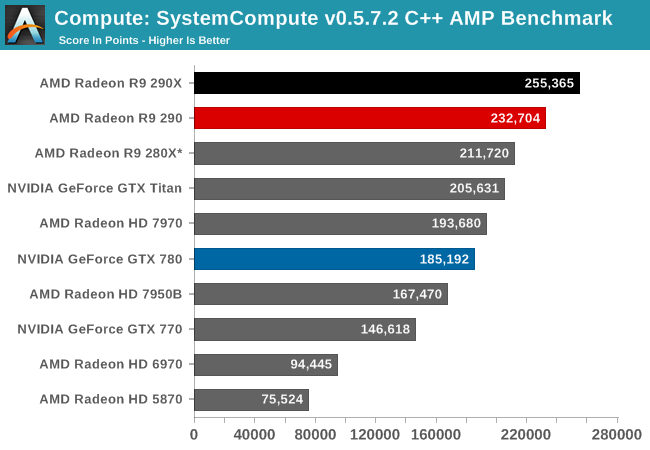
SystemCompute is another benchmark where 290 and 290X do not experience meaningful throttling, and as such are separated by more than what happens in our gaming benchmarks. In this case 290 yet again trails 290X by 9%, though it still enjoys a considerable lead over the GTX 780 and all other NVIDIA cards.










295 Comments
View All Comments
JacFlasche - Thursday, November 14, 2013 - link
Just in time for Xmas! Brilliant. I think the rest of you guys should really avoid this card because of the noise. It is horrendous. Do not buy this card no matter what you do. I of course will buy two of them myself, since they will be totally emmersed in a mineral oil/nano-diamond slurry that can be pumped through a tank in an old ice cream maker I now use as a chiller. All set up in a hand made solid copper tank I scavanged from an old still, and looking quite steam punk with oversized analog gauges and big old hand set revets and such. Not a laptop. Completely silent when the compressor is not on. The compressor really isn't needed for a decent overclock with a few hundred pounds of copper pennies suspended less than an inch above the MB components, bathed in the same nanodiamond slurry. Total silence, except for my gaggle of hard drives when they are on. I have been waiting for you Radion 290, I will freeze your nuggies off, with no sound at all. Ah ha ha (simulated mad scientist laugh) Why pay the big bucks for a little nanodiamond in your transformer coolent when you can use food grade mineral oil and lots of nanodiamonds. Nanodiamonds almost rule for heat conduction. Way way better than metal of any kind. And they lubricate any mechanism they flow through. This is why the very best heat pipes contain nano diamonds in their working fluid. As little as one half of one percent to four percent nano diamond make huge gains in performance. Can't give exact figures if interested look it up.rcrossw - Saturday, November 16, 2013 - link
having read many articles on the noise of this card R290, I have no problem with it being slightly loader than my old 7850. I set at work with an old IBM 4227 DOT Matrix Printer that prints like a Locomotive going by, with the wistle Blowing - that can be nerve and hearing shattering. As for the heat, after 4 days of use, the only problem can be with intense play on games such as Rome Total War II, and Battlefield 4 at highest setting - does get warm. The Sapphire Card I have is fine other wise. The vendors do need something with a better cooling ability. Perhaps, trying Water Cooling, or multiple fan solution. Oh BTW, can be used as a reserve of heat in cold climates during the winter!Texax - Saturday, November 16, 2013 - link
I see a lot of performance praise here but I also see that people are not really aware that this thing runs 10 degrees hotter and 7db louder. It might not seem big of a difference in numbers but its BIG!JackBootedThug - Saturday, November 16, 2013 - link
This card is quieter than my GTX465 which I have been using for a couple of years.http://www.anandtech.com/show/3745/nvidias-geforce...
Why wouldn't I buy it? LOL
It is all relative.
lanskywalker - Monday, November 18, 2013 - link
Definite buy on this!!!!!!! Can't wait!!!!!!! Time to sell my GTX 670 and bought this instead! Arghhhhhh... Thanks AMD!Landiepete - Monday, November 25, 2013 - link
I installed the Gigabyte variety of this card over the weekend and ran Bioshock Infinite and Crysis 3 over a period of several hous while actually playing the games.It sits in a HAF-X case under my desk. For sound I use simple ear buds, sometimes in only one ear because the missus has imporatnt things to communicate at randomized intervals.
And I'm calling bullshit on the noise issues. Yes, there is a clear difference between idle, MS Office and Crysis 3 applications. But at no time whatsoever the noise was excessive or annoying. This may of course be different if you run an open testbed on your desktop.
But for a regular install in a closed case I cannot fault it. In fact, the Gainward GTX 570 GS installed in the Antec P182 case that SWMBO's desktop uss is a hell of a lot noisier.
If I were a conspiracy theorist I would suspect Anandtech was looking for an excuse to sink this brilliant piece of AMD hardware.
lanskywalker - Wednesday, November 27, 2013 - link
Damn happy I bought mine! and get rid of my GTX 670. 70-80 average fps and 100++++ max fps in Battlefield 4 on ULTRA is a pleasure! :DDmaduser2005 - Thursday, November 28, 2013 - link
Please add litecoin mining to compute section.MDX - Wednesday, January 8, 2014 - link
+1 thisSolMiester - Tuesday, December 3, 2013 - link
Have the CF Eyefinity drivers with frame pacing been released yet? Or should I just ask will they be released?